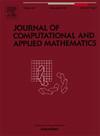非线性泛函混合积分方程的高效高阶算法
IF 2.6
2区 数学
Q1 MATHEMATICS, APPLIED
Journal of Computational and Applied Mathematics
Pub Date : 2025-09-25
DOI:10.1016/j.cam.2025.117096
引用次数: 0
摘要
尽管非线性泛函混合Volterra-Fredholm方程(VFIEs)应用广泛,但对其数值分析的关注并不多。此外,求解非线性积分方程的一个众所周知的挑战是同时实现高阶精度,计算效率和避免求解非线性代数系统的问题。对于Banach空间中的收缩映射,不动点迭代法可以解决求解系统的问题。然而,计算效率、高阶精度和近似功能VFIEs的问题在很大程度上仍未得到解决。本文提出了一种新的培养规则,并应用于非线性泛函混合VFIEs的高(四)阶方法。为了保证计算效率和避免求解系统,提出了一种高斯-塞德尔算法(GSTA)。在GSTA的这种情况下,收敛性证明变得相当具有挑战性(难怪低效的jacobi型思想在文献中非常流行)。利用Banach收缩原理和数学归纳法,严格证明了该方法的四阶收敛性。数值算例验证了理论收敛结果。我们相信,本文给出的数值格式和收敛性证明将为研究人员设计和分析其他积分方程的高效高阶格式,甚至在更高的维度上。本文章由计算机程序翻译,如有差异,请以英文原文为准。
Efficient high-order algorithm for nonlinear functional mixed integral equations
Despite the wide applications of nonlinear functional mixed Volterra-Fredholm equations (VFIEs), not much attention has been paid to their numerical analysis. Further, a well-known challenge in solving nonlinear integral equations is the problem of simultaneously achieving high-order accuracy, computational efficiency and avoiding to solve nonlinear algebraic systems. For contraction maps in Banach spaces, fixed-point iterative methods can address the problem of solving systems. However, the issues of computational efficiency, high-order accuracy, and approximation of functional VFIEs remain largely unaddressed. In this article, a new cubature rule is proposed and used to develop a high (fourth) order method for nonlinear functional mixed VFIEs. To ensure computational efficiency and avoid solving systems, a Gauss–Seidel-type algorithm (GSTA) is formulated. In this case of GSTA, the convergence proof becomes quite challenging (no wonder the inefficient Jacobi-type idea is very popular in the literature). We use the Banach contraction principle and mathematical induction to rigorously prove the fourth-order convergence of the method. Several numerical examples are used to verify the theoretical convergence results. It is our belief that both the numerical scheme and convergence proof presented in this paper will serve researchers in devising and analyzing efficient, high-order schemes for other integral equations, even in higher dimensions.
求助全文
通过发布文献求助,成功后即可免费获取论文全文。
去求助
来源期刊
CiteScore
5.40
自引率
4.20%
发文量
437
审稿时长
3.0 months
期刊介绍:
The Journal of Computational and Applied Mathematics publishes original papers of high scientific value in all areas of computational and applied mathematics. The main interest of the Journal is in papers that describe and analyze new computational techniques for solving scientific or engineering problems. Also the improved analysis, including the effectiveness and applicability, of existing methods and algorithms is of importance. The computational efficiency (e.g. the convergence, stability, accuracy, ...) should be proved and illustrated by nontrivial numerical examples. Papers describing only variants of existing methods, without adding significant new computational properties are not of interest.
The audience consists of: applied mathematicians, numerical analysts, computational scientists and engineers.

 求助内容:
求助内容: 应助结果提醒方式:
应助结果提醒方式:


